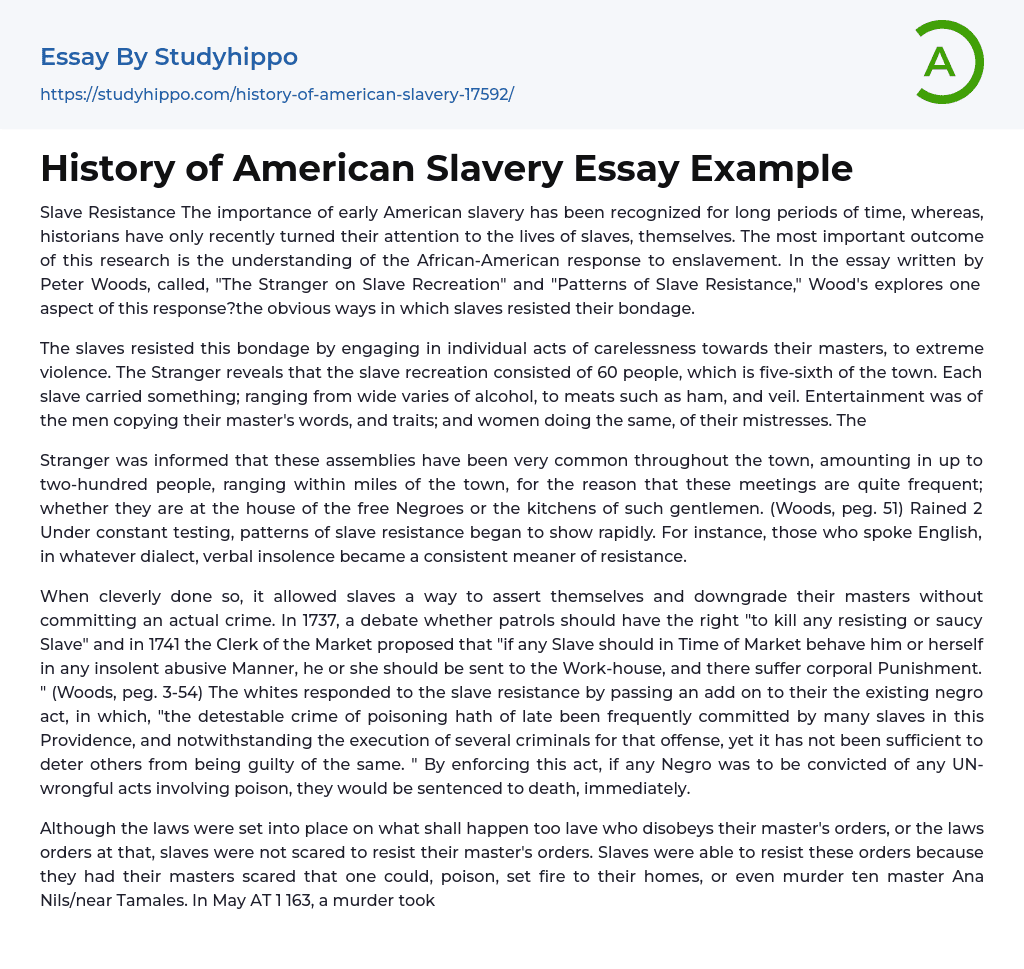The significance of early American slavery has long been acknowledged, but only recently have historians started focusing on the experiences of slaves themselves. Peter Woods explores one aspect of African-American response to enslavement in his essays "The Stranger on Slave Recreation" and "Patterns of Slave Resistance." These essays discuss how slaves resisted their bondage, ranging from individual acts of carelessness towards their masters to extreme acts of violence.
According to Woods, slave recreation involved around 60 people, which was about five-sixths of the town's population. During these gatherings, slaves carried various items, including alcohol and meats like ham and veal. The entertainment included men imitating their masters' words and behaviors, while women did the same with their mistresses. The gatherings were quite common throughout the town, with up to two hundred people att
...ending, sometimes held at the homes of free Negroes or in the kitchens of gentlemen. This frequent occurrence led to rapid development in identifying patterns of slave resistance.
Regardless of their dialect, English-speaking individuals employed verbal insolence as a consistent means of resistance. When executed cleverly, it provided slaves with a way to assert themselves and degrade their masters without committing a formal offense. In 1737, a debated arose regarding whether patrols should be granted the authority to "kill any resisting or saucy Slave." Furthermore, in 1741, the Clerk of the Market suggested that any slave behaving insolently or abusively during market time should be sent to the workhouse and subjected to physical punishment. In response to slave resistance, the white population amended the existing negro act to address the increasingly prevalent crime of poisoning committed by slaves. Despite previous executions for thi
offense, the deterrent effect was insufficient. Consequently, any convicted Negro engaging in wrongful acts involving poison would face immediate death. These laws aimed to regulate slave behavior and disobedience towards masters or the law itself. However, despite the consequences outlined in these laws, slaves were not afraid to resist their masters' orders.Slaves had the ability to defy their masters' commands, provoking fear by threatening actions such as poisoning, arson, and even murdering the masters and their loved ones. An example of this occurred in May of 1631, when a homicide transpired in a village close to Orangeroot. The African American slave killed the master's wife, who happened to be a sixteen-year-old daughter, as well as their infant child. Subsequently, the slave wore the owner's garments and initiated a fire in their residence.
- Russian Empire essays
- Ancient Greece essays
- British Empire essays
- Historical Figures essays
- Nazi Germany essays
- Roman Empire essays
- War essays
- Revolution essays
- 19Th Century essays
- Historiography essays
- History of the United States essays
- 20Th Century essays
- World History essays
- Vikings essays
- Declaration of Independence essays
- Civilization essays
- Evidence essays
- Genocide essays
- Colonialism essays
- Rebellion essays
- 1960S essays
- 1920S essays
- 1950S essays
- Letter from Birmingham Jail essays
- Louisiana Purchase essays
- The Columbian Exchange essays
- World Hunger essays
- What is History essays
- Bravery essays
- Gilded Age essays
- Vladimir Lenin essays
- Alexander The Great essays
- Sparta essays
- Victorian Era essays
- Henry v essays
- Stonehenge essays
- Frederick Douglass essays
- Mahatma Gandhi essays
- Joseph Stalin essays
- Geert Hofstede essays
- George Eliot essays
- Ginevra King essays
- John Keats essays
- Siegfried Sassoon essays
- Ben jonson essays
- Billy elliot essays
- Wilkie collins essays
- John Proctor essays
- Harriet Tubman essays
- Napoleon essays




